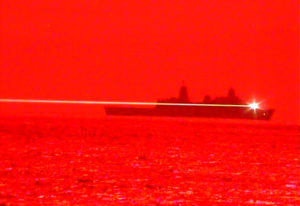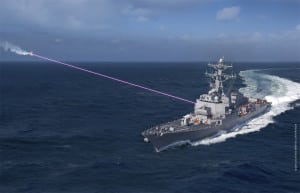The Navy is considering basing laser weapons from aircraft carriers and unmanned surface vessels (USVs) to help protect naval groups from Chinese missiles in the future, the service’s top officer said Wednesday.
“We’ve always had a defense in depth approach to defending the fleet. Where we’re going with this and where we’re putting a lot of R&D money and actually experimenting on ships right now is with laser technology,” Chief of Naval Operations Adm. Michael Gilday said during a virtual Center for a New American Security event. He was responding to a question on how the Navy is dealing with Chinese military technology developments that can threaten aircraft carriers and the fleet generally.

“You don’t want to make any investments without taking a look at what your competitors are doing, right? So our primary competitor, China, is putting a lot of money into space and they’re putting a lot of money into missile systems so they want to be able to find you, target you, and then put a missile on.”
Gilday said the Navy can defend itself against that via “a lot of very expensive, exquisite missiles,” but that is “quite frankly unaffordable.”
The alternative achievable defense is moving towards laser technology, the CNO said.
“When you take a look at the Ford-class carriers…they generate three times the electrical power than the Nimitz-class did, so they have the capacity of laser technology. The same with the Zumwalts, and I would argue the same with unmanned,” Gilday said.
“We can look at unmanned platforms and those unmanned are going to work together with manned. Think of a surface action group that may have a couple of manned ships and it may have a number of unmanned platforms with a bunch of different capabilities. One of those capabilities could be laser technology to defend ourselves,” he continued.
The Navy is working on several directed energy laser systems, with none based on unmanned vessels or carriers yet. This includes the 150-kW Laser Weapon System Demonstrator (LWSD) on the USS Portland (LPD-27) amphibious transport dock due to deploy to the Indo-Pacific next year, integration of the Lockheed Martin [LMT] 100-kW-range High Energy Laser and Integrated Optical-dazzler with Surveillance (HELIOS) for use on a DDG-51 Flight IIA destroyer later this year, and the Optical Dazzling Interdictor, Navy (ODIN) counter-unmanned aerial vehicle (UAV) system first installed on the USS Dewey (DDG-105) in 2019.
Last year, the Navy successfully shot down a UAV using the LWSD on LPD-27. It was developed by Northrop Grumman [NOC] with funding from the Office of Naval Research (Defense Daily, May 26, 2020).
Lockheed Martin delivered the HELIOS system to the Navy in January, and is set to be installed on a destroyer later this year. It sends out a single laser beam to disable smaller targets like UAVs and small fast attack boats. The system also provides a counter-UAV intelligence, surveillance and reconnaissance (ISR) dazzler capability and feeds additional ISR data to the ship combat system (Defense Daily, Jan. 11).
Separately, the Navy plans to install seven more ODIN counter-UAV systems on surface vessels like destroyers. It is used exclusively as a dazzler to blind electro-optical and infrared detection sensors, potentially confusing seekers on incoming cruise missiles as well as cameras used for ISR on opponent aircraft or vessels.
The CNO’s sentiment matches what outgoing Commander of Indo-Pacific Command Adm. Philip Davidson said during a House Armed Services Committee hearing last month (Defense Daily, March 10).
“We are going to have to layer in some defensive weapon capabilities and this is where I think directed energy is going to make its entrée into the joint force. Very encouraged by it,” Davidson said.

In the near term, Gilday expressed confidence the Navy can defend the fleet, repeating the service’s line that aircraft carriers are the most survivable airfields in the world since they can move.
He compared a carrier to Reagan National Airport near the Pentagon. While it stays in one place, if it were a carrier, by the same time tomorrow it could be off Miami, Newfoundland, or as far as Mississippi and Missouri.
Gilday said carrier survivability is also not just mobility and what it carries onboard to defend itself.
“Remember we’re using all domains now. So we’re leveraging space, we’re leveraging cyber, we exercise to that, we practice to it frequently, we feel like our force is pretty survivable now. But again, not to take anything for granted – laser technology is our future.”